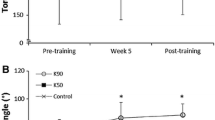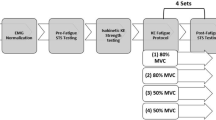Abstract
The isokinetic forces, during 50 repeated maximal knee extensions with a constant velocity of 3.14 rad · s−1, and muscle cross-sectional area (CSA) of the quadriceps femoris muscles were measured for boys aged 14 years (n = 26) and young adult men (n = 26). As representative scores in the maximal session, the mean values of force (\(\bar F\)) of every five consecutive and all trials were calculated. The CSA was measured by using a B-mode ultrasound technique at the midpoint of the thigh length (l t). The average values of\(\bar F\) at the 1st–5th contractions were 193 (SEM 12) N for the boys and 303 (SEM 13) N for the young adults. The average decline of\(\bar F\) with 50 contractions, expressed as a percentage of the value in the 1st–5th trial, was higher in the young adults than in the boys:\(\bar F\) for the young adults was reduced by 48 (SEM 2.9)%, for the boys by 36 (SEM 3.1)%. The\(\bar F\) of every five consecutive and all trials were significantly correlated to the product of CSA andl t (CSA ·l t) in separate groups: for the boysr = 0.762–0.894 (P < 0.01), for the young adultsr = 0.598–0.837 (P < 0.01). In a trial range between the 1st–5th and 11th–15th contractions, the young adults showed significantly higher values in the ratio of\(\bar F\) to CSA ·l t (\(\bar F\) · CSA−1 ·l t) than the boys. However, the difference between groups of the ratio on and after the 16th–20th trial and for all trials became insignificant. Thus, at least for 50 maximal repeated knee extensions, the 14-year-old boys were inferior to the young adults in their ability to produce force during the earlier sessions even when the difference in muscle size was allowed for. The inferiority in the boys might be attributed to a lower reliance on glycolysis as pointed out in previous biochemical studies.
Similar content being viewed by others
References
Bell RD, MacDougall JD, Billeter RB, Howald H (1980) Muscle fibre types and morphometric analysis of skeletal muscle in six-year-old children. Med Sci Sports Exerc 12:28–31
Blimkie CJR, Roache P, Hay JT, Bar-Or O (1988) Anaerobic power of arms in teenage boys and girls: relationship to lean tissue. Eur J Appl Physiol 57:677–683
Chasiotis D, Hultman E, Sahlin K (1983) Acidotic depression of cyclic AMP accumulation and phosphorylase b to a transformation in skeletal muscle of man. J Physiol 335:197–204
Colliander EB, Dudley GA, Tesch PA (1988) Skeletal muscle fibre type composition and performance during repeated bouts of maximal, concentric contractions. Eur J Appl Physiol 58:81–86
Eriksson BO, Gollnick PD, Saltin B (1973) Muscle metabolism and enzyme activities after training in boys 11–13 years old. Acta Physiol Scand 87:485–497
Fuchs F, Reddy V, Briggs FN (1970) The interaction of cations with the calcium-binding site of troponin. Biochim Biophys Acta (Amsterdam) 221:407–409
Fournier M, Ricci J, Taylor AW, Ferguson RJ, Montretit RR, Chaitman BR (1982) Skeletal muscle adaptation in adolescent boys: sprint and endurance training and detraining. Med Sci Sports Exerc 14:453–456
Fukunaga T, Roy RR, Shellock PG, Hodgson JA, Lee PL, Kwong-Fu K, Edgerton DR (1992) Physiological cross-sectional area of human leg muscles based on magnetic resonance imaging. J Orthop Res 10:926–934
Hebestreit H, Minura K-H, Bar-Or O (1993) Recovery of muscle power after high-intensity short-term exercise: comparing boys and men. J Appl Physiol 74:2875–2880
Hermansen L (1973) Oxygen transport during exercise in human subjects. Acta Physiol Scand [Suppl] 399
Ikai H, Fukunaga T (1968) Calculation of muscle strength per unit cross-sectional area of human muscle by means of ultrasonic measurement. Int Z Angew Physiol 26:26–32
Ikai M, Shindo M, Miyamura M (1970) Aerobic work capacity of Japanese people. Res J Phys Educ 14:137–142
Inbar O, Bar-Or O (1986) Anaerobic characteristics in male children and adolescents. Med Sci Sports Exerc 18:264–269
Ivy JL, Sherman WM, Miller JM, Maxwell BD, Costill DL (1982) Relationship between muscle\(\dot QO_2 \) and fatigue during repeated isokinetic contractions. J Appl Physiol Respir Environ Physiol 53:470–474
Kanehisa K, Ikegawa S, Tsunoda N, Fukunaga T (1994) Strength and cross-sectional area of knee extensor muscles in children. Eur J Appl Physiol 68:402–405
Kawakami Y, Kanehisa H, Ikegawa S, Fukunaga T (1993) Concentric and eccentric muscle strength before, during and after fatigue in 13 year-old boys. Eur J Appl Physiol 67:121–124
Nakamura Y, Schwartz S (1972) The influence of hydrogen ion concentration on calcium binding and release by skeletal muscle sarcoplasmic reticulum. J Gen Physiol 59:22–32
Nilsson J, Tesch P, Thorstensson A (1977) Fatigue and EMG of repeated fast voluntary contractions in man. Acta Physiol Scand 101:194–198
Robertson SP, Kerrick WGL (1979) The effects of pH on Ca2+-activated force in frog skeletal muscle fibres. Pflügers Arch 380:41–45
Rotstein A, Dofan R, Bar-Or O, Tenenbaum G (1986) Effect of training on anaerobic threshold, maximal aerobic power and anaerobic performance of preadolescent boys. Int J Sports Med 7:281–286
Rutenfrantz J, Andersen KL, Seilger V, Kilmer F, Berndt I, Ruppel M (1981) Maximum aerobic power and body composition during the puberty growth period: similarities and differences between children of two European countries. Eur J Pediatr 136:123–133
Ryushi T, Fukunaga T (1986) Influence of subtype of fast-twitch fibres on isokinetic strength in untrained men. Int J Sports Med 7:250–253
Saavedra C, Lagasse P, Bouchard C, Simoneau J-A (1991) Maximal anaerobic performance of the knee extensor muscles during growth. Med Sci Sports Exerc 23:1083–1089
Sale DG, Norman PW (1982) Testing strength and power. In: MacDougall JD, Wenger HA, Green HJ (eds) Physiological testing of the elite athlete. Canadian Association of Sports Sciences, pp 7–37
Suter A, Herzog W, Sokolosky J, Wiley JP, Macintosh BR (1993) Muscle fibre type distribution as estimated by cybex testing and by muscle biopsy. Med Sci Sports Exerc 25:363–370
Tesch P, Sjodin B, Thorstensson A, Karlsson J (1978) Muscle fatigue and its relation to lactate accumulation and LDH activity in man. Acta Physiol Scand 103:413–420
Thorstensson A, Karlsson J (1976) Fatiguability and fibre composition of human skeletal muscle. Acta Physiol Scand 98:318–322
Vandewalle H, Pérès G, Sourabié O, Stouvenel O, Monod H (1989) Force-velocity relationship and maximal anaerobic power during cranking exercise in young swimmers. Int J Sports Med 10:439–445
Wickiewicz TL, Roy RR, Powell PL, Edgerton VR (1983) Muscle architecture of the human lower limb. Clin Orthop Rel Res 179:275–283
Zanconato S, Cooper DM, Armon Y (1991) Oxygen cost and oxygen uptake dynamics and recovery with 1 min of exercise in children and adults. J Appl Physiol 71:993–998
Author information
Authors and Affiliations
Rights and permissions
About this article
Cite this article
Kanehisa, H., Okuyama, H., Ikegawa, S. et al. Fatigability during repetitive maximal knee extensions in 14-year-old boys. Eur J Appl Physiol 72, 170–174 (1995). https://doi.org/10.1007/BF00964133
Accepted:
Issue Date:
DOI: https://doi.org/10.1007/BF00964133




